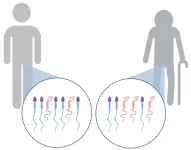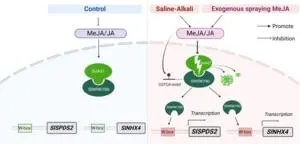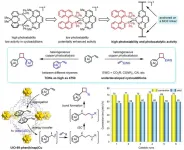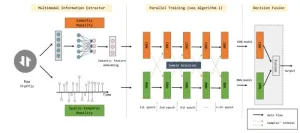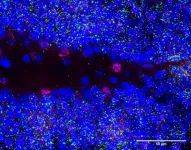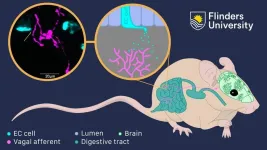(Press-News.org) A new paper in Genome Biology and Evolution, published by Oxford University Press, finds that the link between paternal age and rare congenital disorders is more complex than scientists had previously thought. While researchers have long realized that older fathers are more likely to have children with bone and heart malformations, such as Achondroplasia, Apert, or Noonan syndrome or neurodevelopmental disorders, schizophrenia, and autism, new examination indicates that while the link between some pathogenic mutations increases with paternal age, others do not and may even occur in the father’s testis before sexual maturity.
Delayed fatherhood results in a higher risk of inheriting a new mutation that might result in a congenital disorder in the children. Fibroblast growth factor receptor 3 (FGFR3) is a protein in humans that is expressed in tissues including cartilage, and the brain, intestines, and kidneys.
Driver or selfish mutations, which can result in congenital disorders, are more common in the male germline, orders of magnitude higher than the estimated average human genome mutation rate per cell division per generation. These mutations are more common in the sperm of older men. Despite the importance of driver mutations in the male germline due to their high incidence and the increased frequency, as well as their potential pathogenic effects, researchers do not understand where the mutations really come from and why they are found so often. Do these mutations primarily propagate within the sexually mature germline, leading to an increased mutation burden in the population as men age? Or could driver mutations in sperm of young men already be much higher in numbers than assumed so far, with the risk of young dads having one or even more affected kids?
Researchers here collected sperm samples from anonymous doners at clinics in Austria and investigated the variant frequency for genetic mutations for ten different FGFR3 variants in men aged 23 to 59.
The investigators found that the FGFR3 variant associated with Achondroplasia, the most common form of short-limbed dwarfism, does increase with the father’s age. Another variant, this one associated with Thanatophoric dysplasia—a severe and usually fatal skeletal disorder in children characterized by a disproportionately small ribcage and extremely short limbs—also increased with paternal age. The researchers found that many other FGFR3 variants were unconnected to the father’s age. In particular, the variant associated with CATSHL (Camptodactyly-tall stature-scoliosis-hearing loss) syndrome was not more common in sperm of older men compared to younger men.
“Young dads also face a higher risk of having kids with pathogenic mutations, said the paper’s lead author, Irene Tiemann-Boege.
The paper, “Exploring FGFR3 mutations in the male germline: Implications for clonal germline expansions and parental age-related dysplasias,” is available (at midnight on February 27th) at https://academic.oup.com/gbe/article-lookup/doi/10.1093/gbe/evae015.
Direct correspondence to:
Irene Tiemann-Boege
Institute of Biophysics
Johannes Kepler University
Gruberstrasse 40
4020 Linz, AUSTRIA
irene.tiemann@jku.at
To request a copy of the study, please contact:
Daniel Luzer
daniel.luzer@oup.com
END
Researchers uncover new clues about links between parent age and congenital disorders
2024-02-27
ELSE PRESS RELEASES FROM THIS DATE:
Study reveals parental smoking and childhood obesity link transcends socio-economic boundaries
2024-02-27
A study into parental smoking and childhood obesity has challenged previous notions by revealing that the links between the two are not confined to a specific socio-economic group.
The data shows a strong correlation between parents who smoke and their children’s consumption of high calorie unhealthy foods and drinks, across social classes.
Using longitudinal data on 5,000 Australian children collected over a 10-year period, the research found those living with parents who smoke, on average, eat less healthy, higher calorie food such as fruit juice, sausages, fries, snacks, full fat milk products, ...
HKU chemists pave the way for sustainable organic synthesis with innovative heterogeneous copper photocatalysis, enabling efficient production of diverse bioactive compounds
2024-02-27
Professor Jian HE, from the Department of Chemistry at The University of Hong Kong (HKU), has spearheaded a research endeavour aimed at revolutionising organic synthesis. His research team has successfully developed a novel heterogeneous copper photocatalyst that enables the efficient formation of cyclobutane rings, a crucial structural element in a vast array of bioactive molecules. Cyclobutane rings are prominently featured in pharmaceuticals, natural products, and various biologically active compounds. By enabling researchers to construct these rings easily and selectively, ...
Using multimodal deep learning to detect malicious traffic with noisy labels
2024-02-27
The success of a deep learning-based network intrusion detection systems (NIDS) relies on large-scale, labeled, realistic traffic. However, automated labeling of realistic traffic, such as by sand-box and rule-based approaches, is prone to errors, which in turn affects deep learning-based NIDS.
To solve the problems, a research team led by Yuefei ZHU published their new research on 15 Feb 2024 in Frontiers of Computer Science co-published by Higher Education Press and Springer Nature.
The team ...
Learning and memory problems in down syndrome linked to alterations in genome's ‘dark matter’
2024-02-27
Researchers at the Centre for Genomic Regulation (CRG) reveal that the Snhg11 gene is critical for the function and formation of neurons in the hippocampus. Experiments with mice and human tissues revealed the gene is less active in brains with Down syndrome, potentially contributing to the memory deficits observed in people living with the condition. The findings are published today in the journal Molecular Psychiatry.
Traditionally, much of the focus in genomics has been on protein-coding genes, which in humans constitutes around just 2% of the entire genome. The rest is "dark ...
Race, racism, and covid-19 in the US: lessons not learn
2024-02-27
In The BMJ today, Keisha Bentley-Edwards at Duke University, North Carolina, and colleagues argue that systemic racism and economic inequality are at the root of disparity in covid-19 outcomes and suggest how to distribute resources more equitably.
The article is part of a series that highlights the lessons that can be learned from the US’s covid-19 experience and the actions that are needed to prevent the loss of another million citizens in the next pandemic and improve and protect population health.
"Rather than waiting for the next pandemic to address systemic failures, the ...
Low-Temperature Plasma used to remove E. coli from hydroponically grown crops
2024-02-27
A group led by researchers at Nagoya University and Meijo University in Japan has developed a disinfection technology that uses low-temperature plasma generated by electricity to cultivate environmentally friendly hydroponically grown crops. This innovative technology sterilizes the crops, promoting plant growth without the use of chemical fertilizers. Their findings appeared in Environmental Technology & Innovations.
In hydroponic agriculture, farmers cultivate plants by providing their roots with a nutrient solution. However, the nutrient solution can become infected with pathogenic E. coli strains, contaminating the crop and leading to foodborne illnesses.
To avoid ...
UK cancer treatment falls behind other countries
2024-02-27
Two major studies part-funded by Cancer Research UK reveal that the use of chemotherapy and radiotherapy in the UK has lagged behind comparable countries in the past decade
Patients faced longer waits to begin key cancer treatment, which could be impacting people’s chances of survival in the UK
With an upcoming UK general election, Cancer Research UK is calling on political leaders to step up and ensure patients get the level of care that they deserve
People in the UK were treated with chemotherapy ...
Gut-brain communication turned on its axis
2024-02-27
The mechanisms by which antidepressants and other emotion-focused medications work could be reconsidered due to an important new breakthrough in the understanding of how the gut communicates with the brain.
New research led by Flinders University has uncovered major developments in understanding how the gut communicates with the brain, which could have a profound impact on the make-up and use of medications such as antidepressants.
“The gut-brain axis consists of complex bidirectional neural communication pathway between the brain and the gut, which links emotional and cognitive ...
NSF and DOE establish a Research Coordination Network dedicated to enhancing privacy research
2024-02-27
In response to the rapidly evolving landscape of data collection and analysis driven by advances in artificial intelligence, the U.S. National Science Foundation (NSF) and the U.S. Department of Energy (DOE) have established a Research Coordination Network (RCN) dedicated to advancing privacy research and the development, deployment and scaling of privacy enhancing technologies (PETs). Fulfilling a mandate from the "Executive Order on the Safe, Secure, and Trustworthy Development and Use of Artificial Intelligence," the initiative advances the recommendations in the National Strategy to Advance ...
Want to encourage allyship? Highlight its appreciation, research shows
2024-02-27
Allyship — the practice of relatively advantaged group members acting with the intention to support, advocate and improve circumstances for relatively disadvantaged groups — is critical to promoting more inclusive and equitable organizations.
Not only are advantaged group members typically received more favorably within an organization than disadvantaged group members would be when they speak out against injustice, their allyship can improve disadvantaged group members’ psychological experience in the organization. For instance, men are more likely to believe other men, compared with women, when they confront sexism. And Black Americans report higher levels of self-esteem ...
